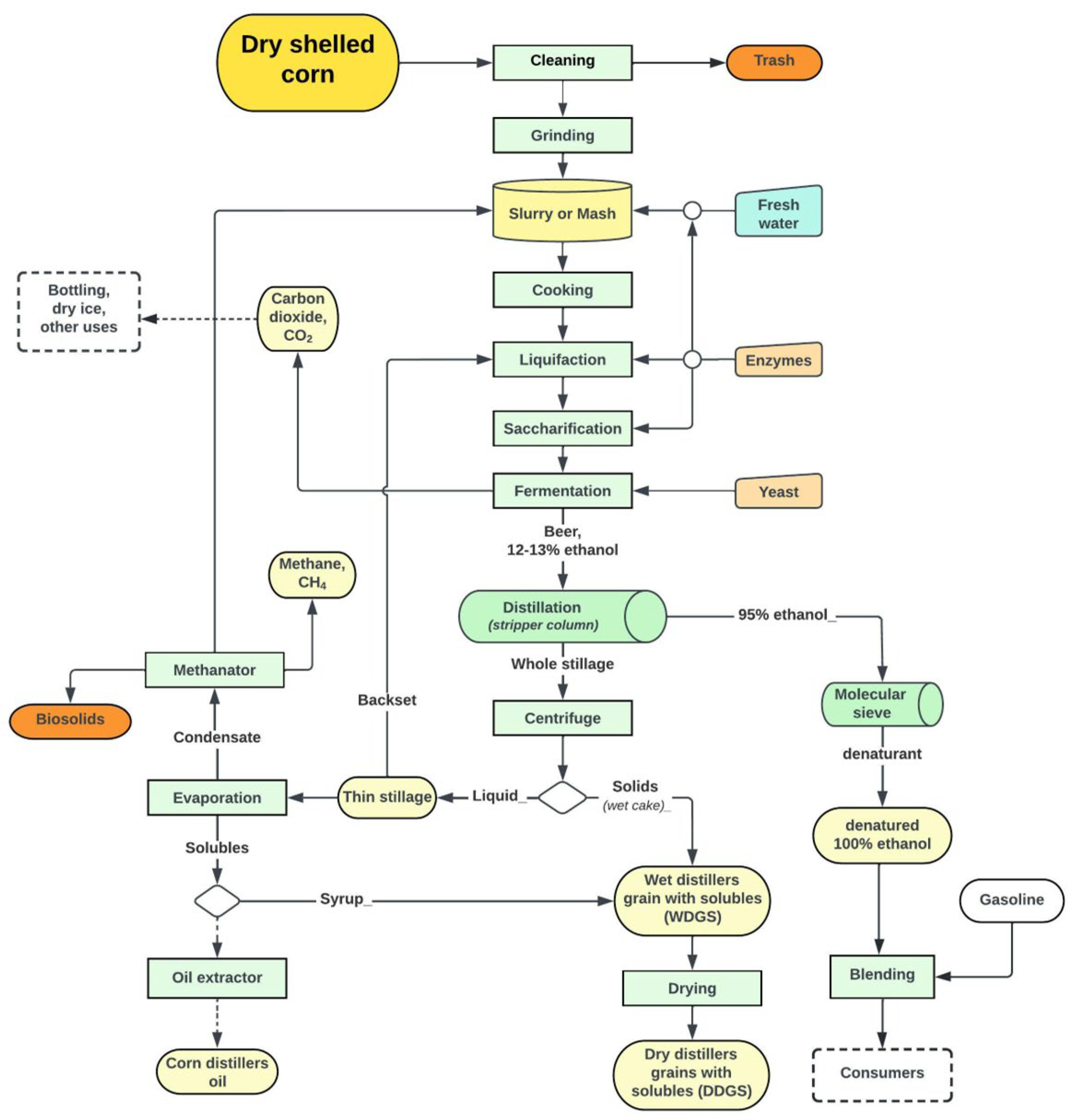⇦ Back to Livestock and Feedstuff Management Home
¶ Introduction
Dry grind processing has become the primary method for ethanol production because of its lower investment, lower operational requirements, and improved fermentation technology. The entire corn kernel is used during the fermentation process without separating out the various grain components.
As a rule of thumb, each bushel of corn (56 lb.) will be converted into approximately 2.8 gallons of ethanol(C2H5OH, CH3CH2OH), 18 lb. of carbon dioxide (CO2), and 18 lb. of distillers grains with solubles (DGS).
Whole corn kernels are screened and hammer-milled to a flour, which is a medium-coarse to fine-grind “meal”. The meal is slurried with water to form a “mash”. Enzymes are added to split the longer-chain starch molecules into simple sugars, glucose and dextrose (C6H12O6). Ammonia is added for pH control and as a nutrient to the yeast.
This mash is cooked and sterilized to reduce non-desirable bacteria levels ahead of fermentation. Yeasts are added after the mash cools and fermentation - conversion of glucose to ethanol and carbon dioxide - begins.
Fermentation generally takes about 40 to 50 hours. The mash is agitated and kept cool during fermentation to facilitate the activity of the yeast. The carbon dioxide released during fermentation is captured and sold for use in carbonating soft drinks and beverages and to produce dry ice.
After fermentation, the resulting "beer" (about 12% to 15% ethanol) is transferred to stripper columns. These columns remove the ethanol from the beer. The ethanol is concentrated to about 85% (190 proof) using conventional distillation. A molecular sieve system is used to dehydrate the ethanol to approximately 100% (200 proof).
The anhydrous ethanol is then blended with about 2% to 5% of a denaturant (such as natural gasoline). This renders it undrinkable and not subject to beverage alcohol tax. It is then ready for shipment to gasoline terminals or retailers for consumer use.
The water and solids that remain after stripping are referred to as "stillage" or “whole stillage”, having about 5% to 15% solids content. It is centrifuged to separate the coarse grain solids from the liquid solubles. These co-products eventually become distillers grains, as well as corn distillers oil.
The liquid is referred to as “distillers solubles” or “thin stillage”. Thin stillage can be concentrated to about 30% solids in an evaporator to become “condensed distillers solubles (CDS)”, also called “syrup”
The coarse solids or “wet cake” that is collected from the centrifuge are known as “wet distillers grains (WDG)”. Wet distillers grains and syrup are combined to form “wet distillers grains with solubles (WDGS)” This product can be dried to form “dried distillers grains with solubles (DDGS)”, a high quality, nutritious livestock feed.
¶ Figure 1. Dry Corn Milling Process and Products (flowchart)

¶ References
http://indianaethanolproducers.org/wet_milling.html
Ani. Sci. 312, Applied Animal Science: Feedstuffs & Ration Formulation,Oregon State Univ. Extended Campus. https://courses.ecampus.oregonstate.edu/ans312/sitemap.htm
Ethanol Coproducts for Ruminant Livestock Diets. 2008. The Cattle Site. https://www.thecattlesite.com/articles/1632/ethanol-coproducts-for-ruminant-livestock-diets/
How Corn Is Processed to Produce Ethanol. Penn. State Univ. College of Earth and Mineral Sciences. https://www.e-education.psu.edu/egee439/node/6733
Bioethanol production: Feedstock and current technologies. 2013. https://www.researchgate.net/figure/Corn-wet-milling-process-flow-diagram_fig4_258514771